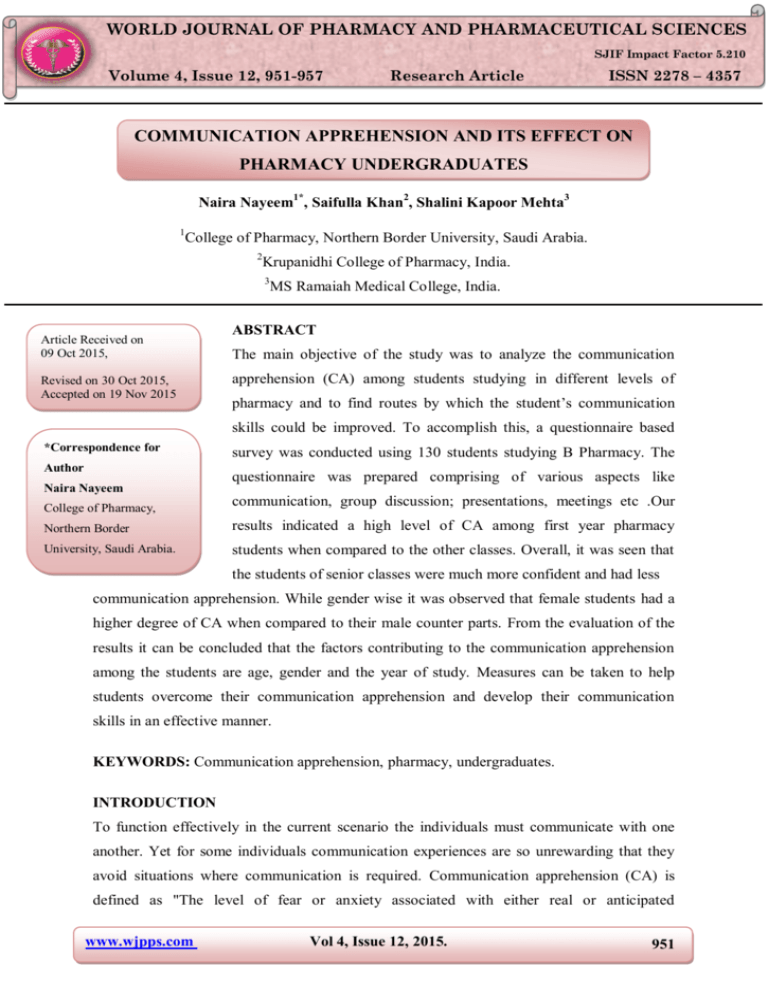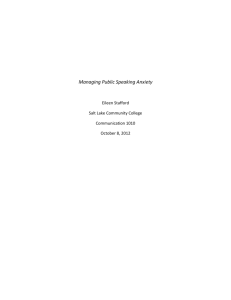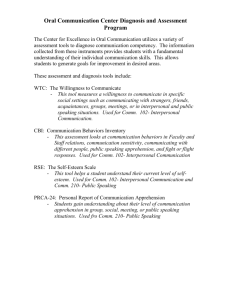COMMUNICATION APPREHENSION AND ITS EFFECT ON
advertisement

WORLD JOURNAL OF PHARMACY AND PHARMACEUTICAL SCIENCES Nayeem et al. World Journal of Pharmacy and Pharmaceutical Sciences SJIF Impact Factor 5.210 Volume 4, Issue 12, 951-957 Research Article ISSN 2278 – 4357 COMMUNICATION APPREHENSION AND ITS EFFECT ON PHARMACY UNDERGRADUATES Naira Nayeem1*, Saifulla Khan2, Shalini Kapoor Mehta3 1 College of Pharmacy, Northern Border University, Saudi Arabia. 2 Krupanidhi College of Pharmacy, India. 3 Article Received on 09 Oct 2015, Revised on 30 Oct 2015, Accepted on 19 Nov 2015 MS Ramaiah Medical College, India. ABSTRACT The main objective of the study was to analyze the communication apprehension (CA) among students studying in different levels of pharmacy and to find routes by which the student’s communication skills could be improved. To accomplish this, a questionnaire based *Correspondence for Author Naira Nayeem College of Pharmacy, survey was conducted using 130 students studying B Pharmacy. The questionnaire was prepared comprising of various aspects like communication, group discussion; presentations, meetings etc .Our Northern Border results indicated a high level of CA among first year pharmacy University, Saudi Arabia. students when compared to the other classes. Overall, it was seen that the students of senior classes were much more confident and had less communication apprehension. While gender wise it was observed that female students had a higher degree of CA when compared to their male counter parts. From the evaluation of the results it can be concluded that the factors contributing to the communication apprehension among the students are age, gender and the year of study. Measures can be taken to help students overcome their communication apprehension and develop their communication skills in an effective manner. KEYWORDS: Communication apprehension, pharmacy, undergraduates. INTRODUCTION To function effectively in the current scenario the individuals must communicate with one another. Yet for some individuals communication experiences are so unrewarding that they avoid situations where communication is required. Communication apprehension (CA) is defined as "The level of fear or anxiety associated with either real or anticipated www.wjpps.com Vol 4, Issue 12, 2015. 951 Nayeem et al. World Journal of Pharmacy and Pharmaceutical Sciences communication with another person or a group of persons”.[1,2] Communication apprehension can cause a barrier to effective communication and hinder the future development of the individual. CA is a pattern of anxiety which can affect much or all of a student's oral communication, social skills and self-esteem. The consequences of CA may be emotional, educational and social. Shyness, low intellectual skills, speech skill deficiencies, social alienation, low self-esteem and differences in cultural divergence may result in CA.[3] Good and effective communication skills are important for the pharmacists as they interact with the patients, their family members and other medical staff.[4] There is a need to improve the communication skills of the pharmacy students which has been emphasized by academicians, industrialists and recruiters. The main objective of the study was to analyze the communication apprehension among students studying in different years of pharmacy and to find methods by which the student’s communication skills can be improved and also to take effective measures to help students overcome communication apprehension. Hence, this study can be instrumental in helping the staff to uncover the levels of CA among students and extend help to students having CA. Knowledge of the actual level of CA can provide clues to find and develop measures that will help the students to reduce problems pertaining to CA. To accomplish this a few questions similar to the personal report of communication apprehension (PRCA-24)[5] was used among a sample of 130 students belonging to different classes to measure their communication apprehension (CA). METHODOLOGY A cross sectional study was conducted among pharmacy undergraduates from the first to final years of B Pharmacy at Bangalore, Karnataka, India. Approximately, 130 students participated in questionnaire based survey. The questionnaire was distributed to the students, collected and evaluated. The prepared questionnaire is as follows. 1. I am uncomfortable in communicating with my fellow friends due to language problem. 2. I am comfortable in discussing subject matter with my fellow friends. 3. I hate participating in group discussions. 4. I get tensed during public speaking. 5. I am uncomfortable in expressing my self in group discussions. 6. I am relaxed in group discussions but can’t express myself. www.wjpps.com Vol 4, Issue 12, 2015. 952 Nayeem et al. World Journal of Pharmacy and Pharmaceutical Sciences 7. I have fear of giving a speech. 8. I am comfortable in communicating with friends of my country/region. 9. I get confused while conversing with new people. 10. I am confident while attending meetings. 11. I am confident while giving presentation. 12. I can easily communicate with my teachers. RESULTS AND DISCUSSION The students selected for this survey belonged to the different classes from the first year to the final year comprising of both male and female students. Table no 2 represents the total number of male and female participants and table no 3 represents the class wise male and female participants. Table no 1: Representation of Students from different classes. Class No of students I Year 35 II Year 30 III Year 30 IV Year 35 Table no 2: Participants in the current survey. No of students sex Male 60 Female 70 Table no 3: Class wise distribution of male and female students. Class Male Female I Year 20 15 II Year 15 15 III Year 15 15 IV Year 20 15 Table 4: Results of the survey. Sl no 1. 2. 3. 4. 5. 6. 7. Questions I am uncomfortable in communicating with my fellow friends due to language problem I am comfortable in discussing subject matter with my fellow friends I hate participating in group discussions I get tensed during public speaking I am uncomfortable in expressing my self in group discussions I am relaxed in group discussions but cant express myself. I have fear of giving a speech. www.wjpps.com Vol 4, Issue 12, 2015. Yes No No answer 70 21 09 60 60 42 50 30 56 30 35 30 38 50 30 10 05 28 12 20 14 953 Nayeem et al. 8. 9. 10. 11. 12. World Journal of Pharmacy and Pharmaceutical Sciences I am comfortable in communicating with friends of my country/region I get confused while conversing with new people I am confident while attending meetings I am confident while giving presentation. I can easily communicate with my teachers. 90 48 40 41 56 10 26 30 31 30 00 26 19 29 14 The results have revealed that 70% of the students were uncomfortable in communicating with their fellow friends due to language problem. This may be attributed to their anxiety, inability to comprehend and negative classroom experiences.[6] About 60% were comfortable in discussing subject matter with their fellow friends as they may be competent, well versed and knowledgeable in the subject. 60% were comfortable in participating in group discussions. The reason for this preference could be that group discussion is usually attended by familiar group members who help and motivate other participants to express their opinions. About 42% students were not keen on public speaking as it involves delivering a speech in front of an audience and in a new environment which are viewed as undesirable and fearful and can cause anxiety. While 30% of the students were comfortable in public speaking. This group of students has no fear when engaging in conversations and are relaxed when giving speeches this can be attributed to their confidence and exposure to these activities.[7,8] 50% felt uncomfortable in expressing themselves in group discussions. They like participating in group discussions but fear to interact or communicate effectively for fear of negative evaluation by the fellow members of the groups. 40% were comfortable while participating in meetings. This may be due to the fact that students are well prepared what to say before attending the meeting. In addition, the agenda of the meeting is usually known before it begins. On the other hand, 30% of the students did not like meetings because they feel nervous. 56% of the students revealed that they were able to easily communicate with their teachers. This can be attributed to supportive and understanding environment provide by the teachers. 90% of the students opined that they were comfortable in communicating with fellow students of their community because of the similar cultures, background and language. Students feel apprehensive, awkward, shy and insecure when asked to speak English in the classroom. Students who are inhibitive in speaking should be motivated and encouraged by their parents, teachers and peers to improve their communication. 48% feel confused while conversing with new people as they are not aware of the person. They reported feeling tense and nervous when engaging with new people in group discussions and would perform better with people they know. 41% of the students revealed that they were comfortable during presentations as they are well prepared mentally before making their presentations. Students www.wjpps.com Vol 4, Issue 12, 2015. 954 Nayeem et al. World Journal of Pharmacy and Pharmaceutical Sciences prepare specific topics and are aware of flow of the conversation; they also provide some interesting visuals for the presentation to help the audience in perceiving the matter with interest.[9] The findings of the survey have revealed that students with high communication apprehension have the fear of expressing themselves and they attempt to avoid communication with their friends, peers or teachers. The results indicate CA has its strongest impact during the first two years of college while the students of the third and the final years have less inhibition in expressing themselves. These could be due the adaptation and coping to the friends, college atmosphere, the peers and the teachers. This anxiety is a significant in case of the 1st year students as they are just out of their elementary school level and research reveals that at least 11% of the elementary students experience severe CA, and an additional 20% may experience enough anxiety which may need some sort of intervention.[10-12] The results obtained in our study are similar to the reported literature.[13] The current results indicate that any efforts to overcome the impact of CA on students should begin as early as in the first year as students have high speech anxiety and fear at the beginning of the course. The most commonly used treatment for CA in adults has been "systematic desensitization." which includes training in deep muscle relaxation, construction of anxiety-creating stimuli, and the graduated pairing, through imagery, of these anxiety stimuli with the relaxed state.[14] The results of this survey corroborate other studies in suggesting that anxiety negatively affects the learning experience in numerous ways and that reducing anxiety seems to increase acquisition, retention and learner motivation.[15-20] The communication apprehension of the students can be prevented by appointing Academic counselors who can help the students by steering highly apprehensive students towards communication. Teachers play an important role in improving communication as they are cognizant that some students are uncomfortable and can be sensitized to the issue of classroom anxiety. Teachers can create a stress friendly environment, involve themselves in error correction and should encourage group activities and help students to practice speaking in order to reduce their apprehension. The management as their contribution towards communication apprehension can create basic communication courses in the first two years by appointing communication skills trainers to train the students by conducting specialized classes and to develop classroom activities that encourage oral communication. One way to increase awareness among both teachers and students is to offer workshops which would present suggestions for alleviating anxiety.[21] An individual who has good cognitive skills can utilize them effectively in communication and hence face fewer barriers in delivering his or her thoughts and ideas in his environment. www.wjpps.com Vol 4, Issue 12, 2015. 955 Nayeem et al. World Journal of Pharmacy and Pharmaceutical Sciences CONCLUSION The result of the survey has revealed that students have CA at the start of the course. Hence effective measures like classes in personality development, communication skills etc can be introduced to help students overcome their communication apprehension and to develop their communication skills in a more appropriate manner. The teachers and the managements of the institutes can introduce courses which help the students to rise above their communication apprehension. REFRENCES 1. Baldwin HJ, Mc Croskey JC, Tnu Vson TJ. J Clinical Diagno Res., 2009; (3): 1885-1890. 2. Mc Croskey JC. An introduction to rhetorical communication. 4th Ed. Englewood Cliffs, NJ: Prentice-Hall, 1982. 3. Bond BD. Silent Incarceration. Contemporary education, 1984; 55: 95-101. 4. Khan TM, Ejaz MA, Azmi S. Evaluation of Communication Apprehension among first year and final year pharmacy undergraduates. J Clin Diagnos Res., 2009; (3): 1885-1890. 5. www.jamescmccroskey.com/measures/prca 24. 6. Renée VW .Students’ Perspectives on Foreign Language Anxiety. Inquiry, 2003; 8(1). 7. Scott MD, Wheeless LR. The relationship of three types of communication apprehension to classroom achievement. Southern Speech Communi J., 1977; 42: 246-255. 8. Scott MD, Mc Croskey JC, Sheahan ME. Measuring communication apprehension. J Communi, 1978; 25(1): 104-111. 9. Friedrich G, Goss B. "Systematic Desensitization." in avoiding communication: shyness, reticence and communication apprehension. Daly JA and Mc Croskey JC, eds. Beverly Hills, Calif.: Sage Publications, 1984. 10. Garrison JP, Garrison KR. Measurement of Communication Apprehension among Children: A Factor in the Development of Basic Speech Skills. Communication Edu., 1979; 28: 119-28. 11. Harris KR. The Sustained Effects of Cognitive Modification and Informed Teachers on Children's Communication Apprehension. Communication Quarterly, 1980; 28: 47-56. 12. Wheeless LR. Communication Apprehension in the Elementary School. Speech Teacher, 1971; 10: 297-99. 13. Mc Croskey J C. Oral Communication Apprehension: A Summary of Recent Theory and Research. Human Communi Research, 1977; 4: 78-96. www.wjpps.com Vol 4, Issue 12, 2015. 956 Nayeem et al. World Journal of Pharmacy and Pharmaceutical Sciences 14. Glaser SR. Oral Communication Apprehension and Avoidance: The Current Status of Treatment Research. Commun edu., 1981; 30: 321-41. 15. Horwitz EK, Horwitz MB, Cope J. Foreign language classroom anxiety. The Mod Lang J., 1986; 70: 125-132. 16. Albert PR, Ramakrishna TS. Developing Engineering Students’ Communication Skills by Reducing their Communication Apprehension. English Spec Purp World., 2008; 4(20): 7. 17. James C. Mc Croskey, Steven BB and Steven KP. The Impact of Communication Apprehension on College Student Retention and Success. Communi Quart, 1989; 37(2): 100-107. 18. Carmencita P Del Villar. Beginning Filipino students’ attributions about oral communication anxiety. J Media Commun Stud., 2010; 2(7): 159-169. 19. Wan ZM, Noriah I, Deepak S R, Suhaidi E. Students communication apprehension and their choice of communicative activities. Asian J Teach Learn High Edu., 2010; 2(1): 22-29. 20. Jose L, Arquero, Trevor H, John Joyce, Jose A. Donoso, Accounting Students and Communication Apprehension: A Study of Spanish and UK Students, Euro Account Rev., 2007; 16(2): 299-322. www.wjpps.com Vol 4, Issue 12, 2015. 957





